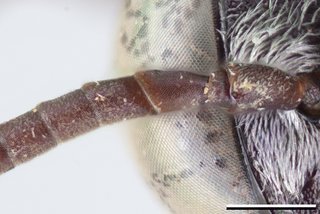
Thomas Onuferko · 9
Epeolus banksi, Antenna female |
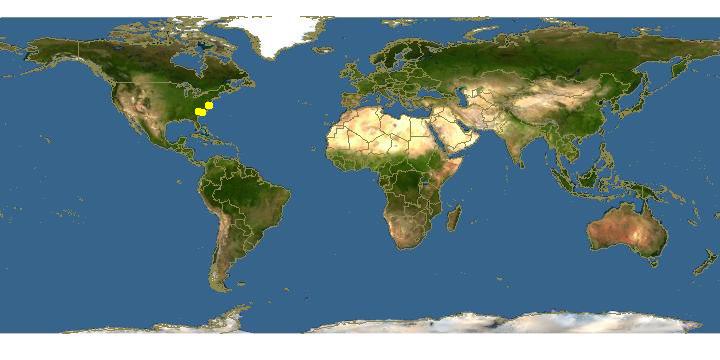
Click on map for details about points.
|
80x5 -
240x3 -
240x4 -
320x1 -
320x2 -
320x3 -
640x1 -
640x2
Set display option above.
Click on
images to enlarge. |
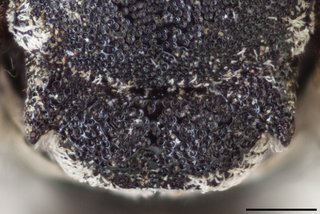
Thomas Onuferko · 9
Epeolus banksi, Axillae mesoscutellum female |
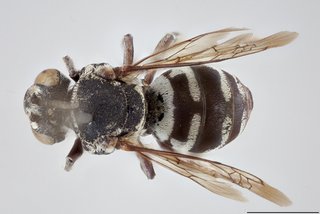
Thomas Onuferko · 9
Epeolus banksi, Dorsal view female |
|
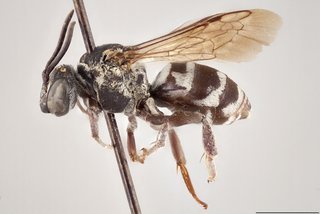
Thomas Onuferko · 9
Epeolus banksi, Lateral view female |
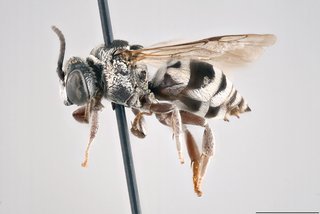
Thomas Onuferko · 9
Epeolus banksi, Lateral view male |
|
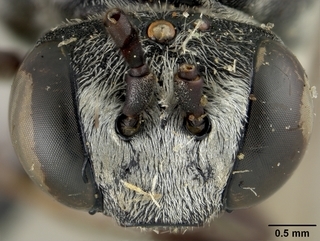
Smithsonian Institution, Entomology Department · 9
Epeolus banksi, face |
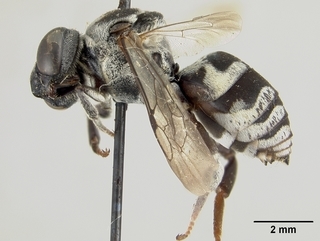
Smithsonian Institution, Entomology Department · 9
Epeolus banksi, side |
|
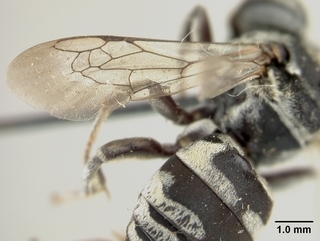
Smithsonian Institution, Entomology Department · 9
Epeolus banksi, wing |
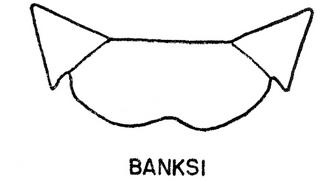
© Rebekah Andrus Nelson
· 1
Epeolus banksi, both, top of thorax |
|
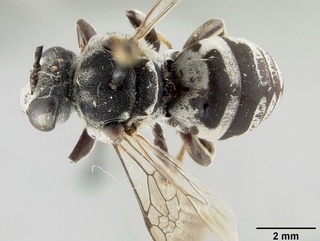
Smithsonian Institution, Entomology Department · 1
Epeolus banksi, top |
|
Overview |
E. minimus and E. banksi are practically indistinguishable - except by location. In Mitchell�s key (1962), he listed the following as differences between the males of these two species. E. Minimus: Mandibles with an acute, inner tooth which is slightly nearer apex than base; mid and hind legs largely ferruginous. E. banksi: Mandibles with a more obtuse, submedian, inner angle; legs largely dark, only the tarsi somewhat reddened. The females are noted to be different in the sculpting of the mesopluera, especially on the lower half. I, however, have either NOT found these differences to be as said or they are not consistent. I have not been able to see a marked difference between the mandible structures in the males. The leg color character does seems to be follow a trend. However, it would be difficult to identify without specimens for comparison as the color difference is slight and the legs of both species are to some degree reddened. Also, the mesopleura character in the females is not consistent, the patterns being too similar to be the basis of dependable identification.
One difference that does seem to be rather consistent is the color of the antennae in the females. E. banksi females have very dark brown antennae with very subtle, if any lightening, anywhere on the antennae. E. minimus females have lighter antennae overall, being a medium brown color, with significant lightening on part of F1 and on the base and apex of the scape. This is not so in the males, at least not to the same extent. In the males, the punctation pattern on the pygidial plate seems to be a rather dependable character. In E. banksi the pits are obvious, moderately deep, and quite dense, though not touching. In E. minimus the pits are shallow and quite sparse, not so noticeable as in E. banksi. In E. minimus the pygidial plate also tends to be lighter in color than the rest of the terga, while in E. banksi it tends to be quite dark, similar to the color of the terga.
Use these characters to support your locality based identification of these two species.
FEMALE�Length 7-10 mm.; black, mandibles ferruginous, tegulae more or less testaceous with dark infusions, tarsi and spurs testaceous, the more basal segments of legs dark; segments of antennal flagellum slightly longer than broad, antennae entirely blackish; lateral ocelli separated from margin of vertex by a space about equal to their diameter; cheeks about half width of eyes, slightly narrowed below, posterior margin subcarinate; median length of labrum considerably greater than half the breadth, with a pair of small, acute, apical denticles; inner margin of mandibles with a distinct, submedian angle or tooth; scutellum outcurved posteriorly, with very slight median impression, axillae rather broadly united to lateral margins, tips only slightly protuberant, reaching very slightly beyond mid transverse line of scutellum (fig. 110); wings with the usual three submarginal cells, sub-hyaline basally, becoming lightly infuscated apically, veins brownish-testaceous; face with some quite dense, silvery tomentum around bases of antennae and lower part of face and clypeus, cheeks with some rather short but dense tomentum which does not hide the surface, upper part of face largely bare or with thin erect hairs; venter of thorax with some rather thin, pale tomentum which does not completely hide surface, pleura below largely bare, becoming quite densely tomentose above; margin of pronotum densely whitish tomentose, this continuing as a marginal fringe around tubercles, scutum with a pair of anterior, longitudinal and rather indefinite lines or patches of whitish tomentum on each side of mid-line, and some whitish tomentum at each extreme side anteriorly, the scutello-mesothoracic suture very finely and obscurely whitish tomentose; metanotum and adjacent areas of scutellum densely white tomentose; posterior face of propodeum rather densely white tomentose on each side of median triangle; anterior face of basal abdominal tergum densely white tomentose, apical margin with a dense and rather broad, transverse fascia which is rather widely interrupted medially, produced toward the base at least at each extreme side, but not quite attaining the more basal tomentose area, the resulting black patch more or less quadrangular, very wide, rather densely covered with very fine black tomentum; terga 2-4 with apical, transverse, fasciae which are slightly removed from rims and more or less widely interrupted medially, less so on tergum 4, slightly constricted at each side but broadened to lateral margins; tergum 5 with a broad, latero-apical patch of pale tomentum on each side, these widely separated medially; vertex and upper part of face densely and rather coarsely rugoso-punctate, with no shining interspaces evident, cheeks somewhat more finely rugoso-punctate, the clypeus and lower portions of face with very fine, densely crowded punctures; scutum closely and rather coarsely rugoso-punctate, the punctures somewhat more distinct on each side anteriorly, very densely crowded toward posterior margin, those on scutellum and axillae slightly coarser but densely crowded; punctures of pleura below rather coarse and deep, but slightly separated, with rather narrow shining inter- spaces evident, becoming densely crowded in tomentose area above; abdominal terga with very fine and close punctures beneath black tomentum, these becoming extremely fine and close on tergum 5; punctures of tegulae deep, distinct, quite close and very fine; pseudo- pygidium transverse, very broadly subtriangular, its median length equal to about one-third the apical width.
MALE�Agrees with description of female in general but segments of flagellum somewhat shorter; front of face with somewhat more copious silvery tomentum; punctures of pleura below somewhat closer, subcontiguous; tomentose area of venter and pleura more extensive; tergum 5 with a transverse, apical, whitish fascia which is slightly interrupted medially; tergum 6 with a narrow apical fascia; pygidial plate rather broadly rounded, median length about equal to basal width, margin carinate, surface rather closely but shallowly punctate.
DISTRIBUTION � Minnesota to New Jersey and North Carolina; April to October.
FLOWER RECORD�Fragaria.
|
|
|
Identification | |
Extracted from: Onuferko TM (2018). A revision of the cleptoparasitic bee genus Epeolus Latreille for Nearctic species, north of Mexico (Hymenoptera, Apidae). ZooKeys 755: 1–185. https://doi.org/10.3897/zookeys.755.23939
Diagnosis. The following morphological features in combination (excluding any that
are specific to the opposite sex of the one being diagnosed) can be used to tell E. banksi
apart from all other North American Epeolus except E. minimus and E. olympiellus:
in females, F2 is at least 1.2 × as long as wide; the mesoscutum has distinct paramedian bands; the axilla is small to intermediate in size, not extending much beyond the
midlength of the mesoscutellum (extending to <2/3 its length) but the free portion is
more than 1/4 as long as the entire medial length of the axilla, and the axilla and mesoscutellum are black; the mesopleuron is closely (most i<1d) and evenly punctate; T1
has a quadrangular discal patch, in dorsal view the longitudinal band is at least half as
wide as the breadth of the apical fascia; and the T2 fascia has anterolateral extensions
of tomentum. Whereas in E. minimus and E. olympiellus the mesoscutum and metasomal terga have bands of off-white to pale yellow short appressed setae, in E. banksi
the mesoscutum and metasomal terga have bands of gray short appressed setae. In E.
banksi, the integument is entirely dark brown or black. In E. olympiellus, at least the
pronotal lobe is ferruginous. In E. minimus from California, the integument is often
entirely dark brown or black, but throughout most of its range E. minimus exhibits
reddish-orange coloration on the labrum, antenna, pronotal lobe, and/or legs, except
foreleg, from trochanters to tarsi. Both sexes of E. banksi are larger (~10 mm in length)
on average than E. minimus or E. olympiellus (7–8 mm in length).
LDiagnosis. The following morphological features in combination (excluding any that
are specific to the opposite sex of the one being diagnosed) can be used to tell E. banksi
apart from all other North American Epeolus except E. minimus and E. olympiellus:
in females, F2 is at least 1.2 × as long as wide; the mesoscutum has distinct paramedian bands; the axilla is small to intermediate in size, not extending much beyond the
midlength of the mesoscutellum (extending to <2/3 its length) but the free portion is
more than 1/4 as long as the entire medial length of the axilla, and the axilla and mesoscutellum are black; the mesopleuron is closely (most i<1d) and evenly punctate; T1
has a quadrangular discal patch, in dorsal view the longitudinal band is at least half as
wide as the breadth of the apical fascia; and the T2 fascia has anterolateral extensions
of tomentum. Whereas in E. minimus and E. olympiellus the mesoscutum and metasomal terga have bands of off-white to pale yellow short appressed setae, in E. banksi
the mesoscutum and metasomal terga have bands of gray short appressed setae. In E.
banksi, the integument is entirely dark brown or black. In E. olympiellus, at least the
pronotal lobe is ferruginous. In E. minimus from California, the integument is often
entirely dark brown or black, but throughout most of its range E. minimus exhibits
reddish-orange coloration on the labrum, antenna, pronotal lobe, and/or legs, except
foreleg, from trochanters to tarsi. Both sexes of E. banksi are larger (~10 mm in length)
on average than E. minimus or E. olympiellus (7–8 mm in length)
Redescription. MALE: Length 9.4 mm; head length 2.3 mm; head width 3.3
mm; fore wing length 7.5 mm.
Integument coloration. Mostly black; notable exceptions as follows: at least partially
ferruginous on mandible, antenna, tegula, and legs. Mandible black except apex reddish brown; preapical tooth same color as mandibular apex (difficult to see in holotype;
described from non-type specimens). Flagellum, except right F1 and F2, missing in
holotype, but brown and (except F1) slightly lighter than conspicuously dark brown
scape and pedicel, primarily due to extensive pilosity on flagellum, in non-type specimens. Wing membrane subhyaline, apically dusky. Legs, except reddish-orange tarsi,
with brown or black more extensive than reddish orange.
Pubescence. Face with tomentum densest on clypeus and around antennal socket,
sparser on upper paraocular area and vertexal area. Dorsum of mesosoma and metasoma with bands of off-white to pale gray short appressed setae. Mesoscutum with
paramedian band. Mesopleuron densely hairy, except for two sparsely hairy circular
patches (one behind pronotal lobe, a larger one occupying much of ventrolateral half
of mesopleuron). Metanotum with tomentum uninterrupted, uniformly off white. T1
with median quadrangular black discal patch enclosed by pale tomentum, except for
medial separation at apex. T2–T6 with fasciae interrupted medially, those of T2–T4 narrowed before becoming somewhat broader laterally, T2 with fascia with anterolateral extensions of sparser tomentum. S4 and S5 with long coppery to silvery subapical
hairs, which individually are often darker apically.
Surface sculpture. Punctures dense. Labrum with larger and sparser punctures (i=1–
2d) than clypeus (i<1d). Small impunctate matte spot lateral to lateral ocellus. Mesoscutum, mesoscutellum, and axilla coarsely and densely rugose-punctate. Tegula very
densely punctate mesally (i<1d), less so laterally (i=1–2d). Mesopleuron with ventrolateral half densely punctate (i<1d); mesopleuron with punctures more or less equally
dense throughout. Metasomal terga with punctures very fine, dense (i≈1d), evenly
distributed on disc.
Structure. Labral apex with pair of small denticles, each preceded by longitudinal carina. Frontal keel not strongly raised. Scape with greatest length 1.6 × greatest
width. F2 noticeably longer than wide (L/W ratio = 1.2). Preoccipital ridge not joining
hypostomal carina, from which it is separated by about 1.5–2 MOD at its terminal.
Mesoscutellum moderately bigibbous. Axilla intermediate in size, its lateral margin
(L) nearly half as long as mesoscutellar width (W) (L/W ratio = 0.4–0.5) and tip not
extending much beyond midlength of mesoscutellum (extending to <2/3 its length);
axilla with tip clearly visible, but unattached to mesoscutellum for less than 2/5 the
medial length of axilla; axilla with lateral margin relatively straight and without carina. Fore wing with three submarginal cells. Pygidial plate apically rounded, with large
deep punctures closely clustered.
FEMALE: Description as for male except for usual secondary sexual characters and
as follows: F2 even longer than wide (L/W ratio = 1.4); T5 with two patches of pale
tomentum bordering and separate from pseudopygidial area present only in female; T5
with pseudopygidial area lunate, its apex more than twice as wide as medial length, indicated by silvery setae on flat disc of apicomedial region elevated from rest of tergum;
S4 and S5 with much shorter hairs (S5 with apical fimbria of coppery to silvery hairs
extending beyond apex of sternum by ~2/5 MOD); pygidial plate apically truncate,
with small, denser punctures.
|
|
|
Names | |
|
|
| Supported by | |
Updated: 2024-04-25 20:53:14 gmt
|